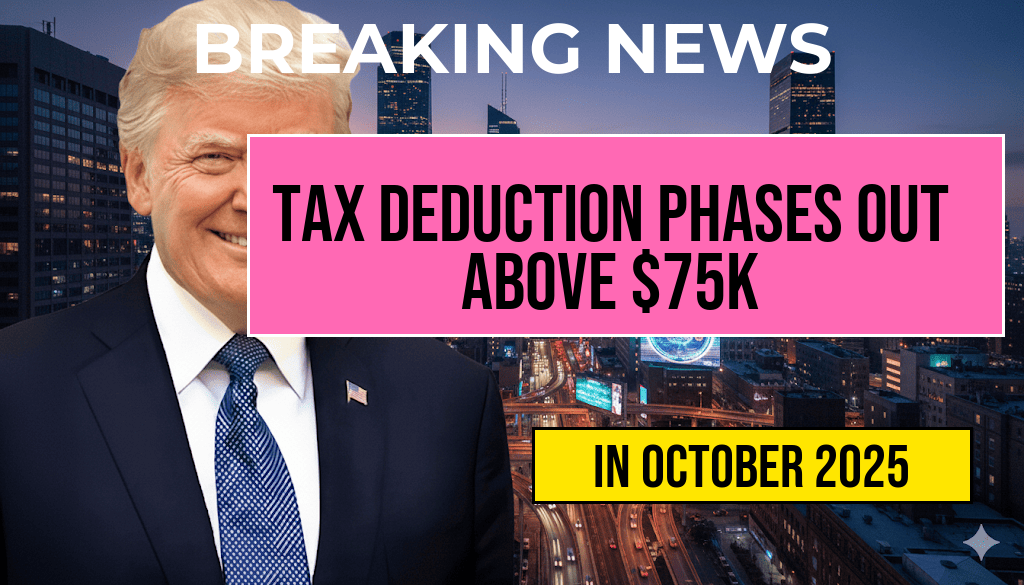The Internal Revenue Service (IRS) has announced a significant change to the tax deduction landscape for middle-income earners. Beginning with the upcoming tax season, the $4,000 tax deduction available to eligible taxpayers will gradually phase out for those earning more than $75,000 annually. This adjustment aims to create a more progressive tax system, ensuring higher earners contribute proportionally more to federal revenues. The phase-out begins at the $75,000 threshold, with the deduction completely eliminated once income surpasses $80,000. This measure impacts millions of taxpayers, particularly those in the moderate-income bracket, and reflects ongoing efforts by lawmakers to refine tax policies in response to economic shifts and budgetary needs.
Understanding the Deduction Phase-Out Mechanism
Details of the Phase-Out Range
| Income Range | Deduction Status |
|---|---|
| Less than $75,000 | Full $4,000 deduction available |
| $75,000 to $80,000 | Deduction gradually decreases |
| Above $80,000 | Deduction eliminated |
For taxpayers earning between $75,000 and $80,000, the deduction is reduced proportionally. As income approaches the $80,000 cap, the deduction diminishes until it is no longer available. This graduated reduction aligns with federal policy aimed at balancing tax relief for middle-income families with increased revenue from higher earners.
Implications for Taxpayers
Many filers who previously benefited from the full $4,000 deduction will see the benefit decrease or disappear entirely, depending on their income level. For example, a family earning $77,500 will be eligible for roughly half of the deduction, while those earning $82,000 will not qualify at all. This change underscores the importance of accurate income reporting and strategic tax planning, particularly for individuals and families near the threshold.
Policy Rationale and Broader Context
Legislative Intent Behind the Adjustment
Lawmakers implementing this phase-out aim to introduce a more equitable tax framework, where higher-income households shoulder a larger share of the tax burden. The adjustment is part of a broader effort to address income inequality and fund federal programs. According to analysis from Wikipedia’s page on U.S. taxation, progressive tax reforms have historically sought to balance revenue needs with fairness.
Economic and Budgetary Considerations
The phase-out of the deduction is projected to generate additional federal revenue, contributing to the deficit reduction initiatives. The Congressional Budget Office (CBO) estimates that such measures could increase federal income by billions over the next decade, depending on overall economic growth and taxpayer behavior.
Impact on Tax Planning and Future Trends
Advisory for Taxpayers
- Review income projections for the current and upcoming tax years.
- Consult tax professionals to optimize deductions and credits before thresholds are reached.
- Consider timing certain income or deductions to maximize benefits within the phase-out limits.
Potential Changes in Tax Policy
Observers anticipate further adjustments to tax laws as lawmakers evaluate the effectiveness of recent reforms. The current phase-out may serve as a precedent for future modifications aimed at refining the balance between revenue collection and tax relief.
Resources for Taxpayers
- IRS official guidance on deduction limits and phase-out details: irs.gov
- Analysis of tax policy impacts from Forbes: forbes.com
- Historical overview of U.S. tax system from Wikipedia: Wikipedia
Frequently Asked Questions
What is the maximum tax deduction available for incomes up to seventy-five thousand dollars?
The maximum tax deduction available is four thousand dollars for individuals earning up to seventy-five thousand dollars annually.
How does the phase-out of the deduction work for higher incomes?
The tax deduction gradually phases out as income exceeds seventy-five thousand dollars, reducing the deduction amount until it is no longer available.
At what income level does the tax deduction completely disappear?
The tax deduction fully phases out once income exceeds a specified threshold above seventy-five thousand dollars, typically around ninety-five thousand dollars, depending on the tax rules.
Can I still claim a partial tax deduction if my income is slightly above seventy-five thousand dollars?
Yes, if your income exceeds seventy-five thousand dollars, you may still be eligible for a partial deduction depending on the phase-out schedule outlined by the tax regulations.
Are there any strategies to maximize tax deductions before income surpasses seventy-five thousand dollars?
Yes, taxpayers can consider timing their deductible expenses or making contributions to retirement accounts before reaching the income threshold to maximize tax benefits.






